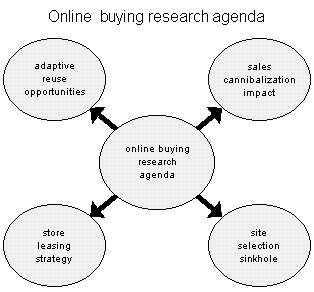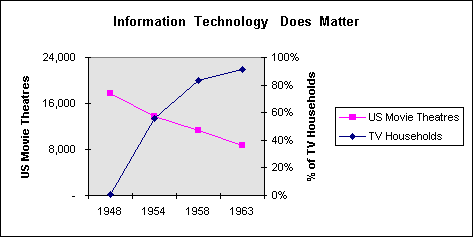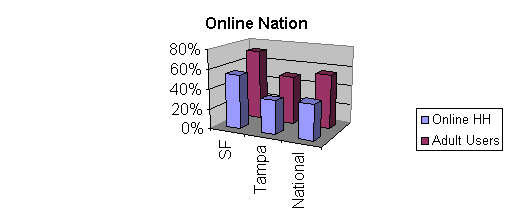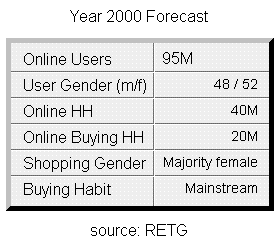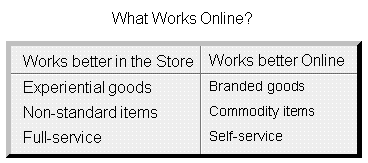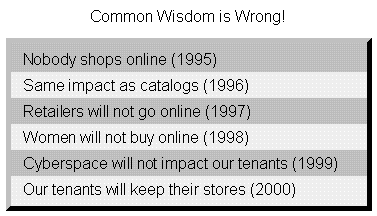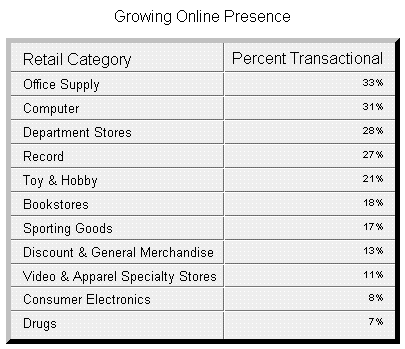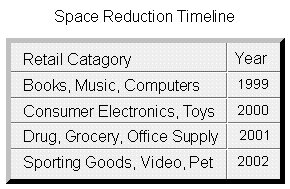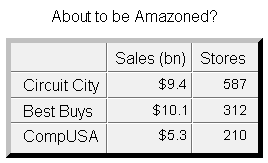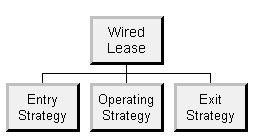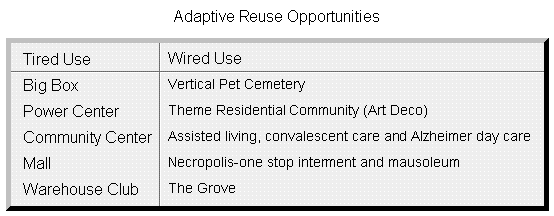Advice from the Experts JUNE 1999 Nowhere Yet Everywhere Mark Borsuk * American Real Estate Society Copyright © 1999. All Rights Reserved. Mark Borsuk.
ABSTRACT In 1998 customers found online buying an irresistible value proposition and voted to make it a mainstream activity. Their vote of confidence presages a cannibalization of in-store sales for many kinds of merchandise as retailers rapidly seek to leverage the online sales channel. Merchants are likely to shift their requirements for new stores, seek to reduce stores within a trade area and selectively downsize them. Their strategy of moving from a pure location based sales channel to cyberspace will have an impact on retail space demand, rents and property values. The academic real estate community is well suited to analyze the critical factors influencing future retailer space decisions. Questions to consider are how online buying impacts individual store financial performance, what are the required changes to site selection methodology in a wired world, what are the strategic leasing options for retailers to consider and what is the adaptive reuse potential for redundant space.
Table of Contents
Nowhere Yet Everywhere Investigating online buying’s impact on retail property values Mark Borsuk * The Real Estate Transformation Group Copyright © 1999. All Rights Reserved. Mark Borsuk. I. The treasure hunt begins! In 1998 customers found the value proposition for online buying irresistible and shopped in record numbers. They voted to make Internet buying a mainstream activity. In-store sales cannibalization is the likely result of their vote of confidence. Although the impact of online buying will be selective across goods and merchants, retailers are going to leverage the online sales channel. Their strategic shift requires limiting new store development, reducing stores within a trade area and selectively downsizing stores. All have an impact on retail space demand, rents and property values. The academic community is well suited to analyze the critical factors influencing retailer decisions about space needs. In addition, developers, investors and Wall Street are just starting to grasp how Internet shopping could erode their wealth. They also need insight from academicians to understand change and how to pick the winners and avoid the losers in a wired world. What important questions do researchers and analysts need to ask about online buying’s impact on property values? This paper reviews the following topics:
II. Culture clash The biggest stumbling block to analyzing online buying’s impact on retail space demand is understanding the fundamentally different views of those in the online and real estate worlds. One deals in an environment of pure abstraction; there is no there there. The other exists in the tactile world. The tactile mind balks at the deracination of activity from place. It is antithetical to believe a location premium could rapidly dissolve in a wired world. Further confusing the issue are the location metaphors used to describe cyberspace like virtual storefront, online mall and cyberspace real estate. Using a real estate metaphor like electronic storefront creates confusion. The image of the store bears no relationship to the void of cyberspace. Rather, it limits one’s ability to see the expanded possibilities of online buying from the customer’s perspective. Thus, place metaphors imprison thinking by conjuring real estate images to analyze an incorporeal phenomenon. One challenge ahead is to create metaphors for the real estate community not linked to physical presence. Finally, time perception is another factor inhibiting the understanding of the forces at work. Real estate time is glacial. It takes weeks, months and sometimes years to bring a development to fruition, complete a sale or negotiate a lease. Conversely, Internet time seems to run on a ninety day cycle of product introduction and upgrades. This time perception displacement works against those in real estate trying to comprehend the impact of the wired world’s diffusion through society. III. Information technology shifts space demand. Three examples illustrate how information technology can impact space demand. The first example is the telegraph. In 1861 the Pony Express folded, nineteen months after the beginning of telegraph service to the West. Television had a pronounced impact on movie theaters. They went into rapid decline from 1948 to 1963. The Chart below depicts a fifty percent drop in theaters over fifteen years while the number of TV households rocketed from less than one percent to ninety percent. The tremendous popularity of TV, an example of information technology, devastated movie theaters. While information technology partially explains the rapid decline in theaters, the population was also shifting to the suburbs. This was also an important factor.
Source: US Census of Business, US Census of Service Industry. SIC Code 7832. Data for movie theaters with payroll excluding drive-ins. Christopher H. Sterling, The Mass Media, Praeger Publishers, 1978. The most recent example of information technology’s impact on space demand is Egghead becoming a pure Internet retailer. The difference between Egghead’s move to cyberspace and earlier events is the ubiquity of everyday tech. A. Impact of everyday tech. Everyday tech is the integration of computer hardware, software, networks and telecommunications into daily life. The diffusion of everyday tech into daily life changes expectations about work, education, leisure and shopping. It severs place from activity. Everyday tech creates options for when and where to work. It also gives the customer a strong incentive to migrate the transaction from the store to cyberspace. Everyday tech’s utility is an expression of the value proposition stated in Metcalfe’s Law 1. The Law describes the value of a network increasing exponentially as the size of the network grows arithmetically. For example, when the Fax was gaining popularity during the 1980s only a modest growth in users was necessary to double or triple the value to users. In other words, the value to the users was growing much more rapidly than the absolute number of new users coming on the network. Online shopping is another example of Metcalfe’s Law. Amazon.com not only provides a vast selection of books at competitive prices but presents customers with an opportunity to author book reviews, receive alerts by email of interesting books and participate in a community. Thus, the online sales channel is a powerful way for retailers to inform, educate, serve and sell to their customers. And for customers it takes the shop out of shopping. The force of Metcalfe’s Law shows up in other ways. The stock market capitalization of Amazon.com ($27bn/AMZN) compared to the combined value of Barnes & Noble ($2.4bn/BKS) and Borders ($1.2bn/BGP) demonstrates the network phenomenon at work. It also indicates the market’s emerging attitude toward location based retailing. Why should the market place a premium on an online merchant having no stores when the competitors have in excess of two thousand? Beyond retailing, the market is making the same assessment on AOL. AOL has a greater valuation than the combination of Walt Disney, Viacom and CBS .2 Everyday tech fundamentally changes lifestyle. This is a critical point in connecting the development of the online buying habit and the impact on stores. Whether shopping for Gap clothes, looking for a book, selecting software, evaluating a dishwasher or comparing different automobiles, it is easier, cheaper and more convenient to do so online. The new buying habit changes people’s expectations about the need for location based shopping. They start to ask, why get into the car to make a purchase when going online will work as well if not better? Their shifting sense of value illustrates Metcalfe’s Law in action. Furthermore, to the degree customers no longer patronize a merchant’s store, the secondary impact is to reduce foot traffic and the synergy with the other retailers in the center or mall. The negative impact on retail property of everyday tech and Metcalfe’s law accelerates as the nation embraces a wired lifestyle. B. Online nation. In the San Francisco Bay Area seventy-two percent of adults (18+) regularly access the Internet and more than half of the households are wired. In the Tampa/St. Petersburg/Sarasota area just under half of the adults regularly use the Internet and a third of households are wired. Nationally, about fifty-five percent of adults regularly use the Internet and online households represent thirty-six percent of total households .3 See Chart below.
Another trend is PC household penetration and percentage of households getting online. In January 1995 thirty-two percent of households owned a PC but only nine percent of households were online. This amounted to only twenty-eight percent of PC households being wired. In January 1999 PC households comprise fifty percent of total households and thirty-three percent of households are online. The percentage of PC households online now equals sixty-six percent .4 This again demonstrates Metcalfe’s Law at work. The expectations of households purchasing PC also includes them getting wired. C. Women lead in broadening the user base. In 1998 the gender gap vanished. For the first time women equaled men online. It only took females three years (Jan 1996 to Jan 1999) to go from eighteen percent of the online population to fifty percent 5. Many retailers and those in retail property underestimated the desire of women to take the plunge into cyberspace believing they lacked the requisite technical knowledge. Not only was their view completely wrong but it continues to hinder them from maximizing the value of the wired world for their primary customers. Along with the move to gender parity, the predominantly online college educated population began to change. Survey data for newer users discloses thirty-nine percent had a high school education or less, whereas twenty-two percent of longer-term users had similar schooling 6. There is growing teenage participation in cyberspace. About thirty-five percent of the nineteen million teenagers are actively online. In 2000 more than half will be actively online 7. Seniors, on the other end of the age spectrum, are rapidly coming online. In sum, whether by gender, education or age Internet users resemble the greater population 8. D. The babes are buying. If there are few online transactions and women do not shop in significant numbers, then there will be little impact on stores despite the growth in the online population. The evidence shows online buying is gathering momentum and women are participating in greater numbers. The February Business Week/Lou Harris Poll showed a rapid growth in online buying by wired households. Those making purchases online went from nineteen percent in 1997 to thirty-one percent in early 1999. Put another way, fourteen percent of adults (18+) made purchases over the Internet 9. Another longitudinal survey conducted in January by Odyssey found forty-seven percent of wired households purchased online during the prior six months. This was up from thirty percent in the prior period. Furthermore, the number of transactions increased from 1.7 to 3.7 10. The predictions for online buying this Christmas are startling. Ziff-Davis forecasts IVQ99 online purchases to more than tripling from $4.1bn to $13.7bn during the 1998 holiday season. This translates to twenty-four million people who are likely to buy against about eight million who purchased last year . 11 The customers’ embrace of online buying will match the rapid growth of women online. Jupiter Communications estimates women comprised thirty-four percent of purchasers in 1998 and will become forty-eight percent of buyers in 2002 . 12 Such projections may be too conservative. Part of the reason lies in the "get online-buy online" time lag assumption made by many forecasters. Similar to the lag between when a household purchases a PC and goes online, there is an observed correlation between getting online and beginning to buy. Forrester Research estimates the lag at about twelve months. This is down from eighteen to twenty-four months . 13 However, today’s generation of women going online are most likely predisposed to quickly start using the Internet for shopping. This suggests a radical reduction in the time lag before women become the majority of buyers. The Year 2000 is the target date. See Table below.
E. What works online? The key to understanding what works online is to view goods through a prism of merchant service. At one end of the spectrum are the typical self-service items, national brands, house brands and goods of uniform quality. In many instances the customer’s only contact with the retailer is at the checkout counter. Conversely, at the other end of the spectrum are goods that require a tactile and aesthetic judgment, are non-standard or require full service. See Table below. A good rule of thumb is, the more experiential and less commodity-like the product, the greater the likelihood the customer will go to the store. Clothes are working well online despite most observers’ reservations. Goldman Sachs (Internet Retailing: Don’t Turn Your Back on It, January 29, 1999) believes leading edge specialty retailers like the Gap and Land’s End are precursors for customized clothing sold over the Net. This would erode one of the major advantages of in-store retailing.
F. Some academics see the opportunity. Other non real estate academics have analyzed the need to bring corporate goals in line with real estate needs to enhance shareholder value and they are shifting their focus to retail. The ability to move transactions into cyberspace thereby reducing the cost of the physical sales channel is a lucrative option for some retailers, especially mass merchandisers. The metrics developed by academics, consultants and firms to align space needs with corporate strategy are well known. As retailers focus on restructuring their store commitments, they will look to this pioneering work. In fact, retailing is already in the academicians’ sights. On October 22, 1998, the Financial Times of London carried an interview with Professor Gary Hamel (p.9) in which he called for a radical change in retailing based on the growth of online commerce. Hamel observed each significant change in retailing created new leaders and those who led could not meet the challenge of the next shift. He also stated the current retailing leaders would struggle to adapt to the Internet ways of doing business. Professor Hamel is best known for his work on developing revolutionary competitive strategies. His analysis examines three issues. First, a company must explicate the orthodoxies and dogmas defining its business. Second, the firm must define and understand its core strengths. Third, it must seek out discontinuities in the environment and turn them into a competitive advantage . 14 Restructuring the retail value chain away from the store fits his schema to develop revolutionary strategy. The prevailing dogma is location based retailing, the core competency for success is merchandising, and the rise of the online sales channel provides the discontinuity necessary to leapfrog the competition. In an odd juxtaposition of views, the prior day’s FT carried an interview with Mr. David Glass, the Chairman of Wal-Mart. Mr. Glass believes electronic retailing will never account for more than a small percentage of sales because "Shopping is a social experience for many people in the world." 15 His comments are interesting for several reasons. First, Wal-Mart sells the kinds of goods likely to be found online. Second, it may only take a small shift in sales to make a Wal-Mart store unprofitable. Third, what is experiential about pushing a shopping cart through a 100,000 sq. ft. building to restock cereal, toilet paper, soap and buy name brands when they are available online? Will market leaders like Wal-Mart succumb to the new competition in a wired world? Implementing Professor Hamel’s ideas would push merchants to eliminate part of the location based sales channel. This would make many stores "stranded assets" and directly impact property values. G. The real Y2K problem. The real Y2K problem for retail real estate is forty percent of households online, women as the majority of buyers and a great number of fully transactional retail Web sites operating in 2000. Parallel to the surge in online sales transactions will be bundle buying and the first retail bankruptcy caused by online competition. 1. Bundle Buying. The stealth competitor Amazon.com demonstrated how quickly an online specialty retailer could develop a large customer base, threaten off-line competitors and achieve market recognition. This is the initial shock online buying brings to retailers. The second shock is bundle buying. Bundle buying is the "next big thing" 16 and should appear in twelve to eighteen months. Bundle buying is a term describing a trusted firm offering a wide variety of goods and services online in an intuitive and easily shopped format. See Table below. The firm would aggregate the best goods and services from the supermarket, large drug store and warehouse club. The products offered would be the most popular at the lowest possible price including free delivery. The sponsor could be a mass merchandiser, a joint venture under the banner of a nationally known firm, a well known financial institution partnering with a recognized category leader, or perhaps Microsoft. Cendant Corporation’s NetMarket is an early version of the bundle buying concept. Customers can purchase groceries, health and beauty items, pet supplies and consumer electronics.
Achieving a critical mass of customers likely requires making the order size small enough for restocking of everyday items while encouraging customers to expand their purchases. Taking orders as low as fifteen dollars would be a great convenience for singles and the elderly. Bundle buying has the capacity to devastate community shopping centers anchored by supermarkets and drugstores as sales migrate online. The potential combination of lower prices, wide selection, convenient delivery, minimum order size and ancillary services should give off-line operators second thoughts about continuing to pursue present leasing and construction plans. 2. The bankruptcy specter. In 2000 the intensity of online competition may cause one well-known retailer to file for bankruptcy or sell out a stronger rival. In either case the result will be the same: termination of or the necessity to renegotiate store leases. The aggressive use of the Bankruptcy Code to terminate lease commitment may become an attractive option for some retailers seeking to leverage the online sales channel. 17 The specter of using bankruptcy as a sword will haunt the property market and force participants to change their views on the security of retail real estate and its investment returns. 3. Common wisdom is wrong! In trying to understand online buying’s potential impact on retail space the analyst confronts deep seated prejudice and hostility. This is understandable given the several thousand year history of location based merchandising. Nevertheless one has to overcome this predisposition to see the possibilities ahead. The Table below puts the prevailing wisdom in a historical context.
IV. Wall Street’s influence. Wall Street is a curse on retail real estate and its salvation in the struggle with online buying. The curse relates to the negative sentiment fomented by analysts and others about retail property in the debt and equity markets. The salvation will come when opportunity capital begins to fund the adaptive reuse of retail space. A. The curse. The 1990s massive securitization of retail property was a pact with the devil. Securitizing retail real estate directly linked it to the trading markets. It is estimated about thirty-five percent ($70bn) of the publicly traded CMBS market is in retail property 18 and retail property equals twenty-one percent ($31bn) of the REIT market. 19 The direct linkage removes the slack that existed to absorb regional, national and international shocks. Formerly, the private, long-term nature of the landlord-tenant relationship separated property from market gyrations. The trend to aggregate properties into securities subjects them to the systemic fragility of trading markets. But while many trading markets are global, giving them greater depth, they also display a greater tendency for normal accidents. Normal accidents come in many forms and occur randomly. A riot in Indonesia, a war in Iraq or trouble in the Balkans all have the capacity to destabilize prices regardless of whether the event directly impacts the underlying asset. Securitizing retail property also created short selling opportunities. This was not possible with private property, but now is done online. Another aspect of securitizing retail property was the creation of a new group of overseers who are unrelated to the risk of ownership. Retail company analysts, REIT analysts, credit rating agencies, the SEC and public relations firms are all part of the value equation. Their opinions drive market expectations and the story is getting worse. For example, during February and March analysts’ sentiment turned decidedly bearish on retail property. Moody’s Investors Services told readers online buying could adversely impact the property used as collateral for mortgages. 20 Green Street Advisors adjusted the cap on retail REITs to reflect the increased risk from online buying. 21 Finally, Merrill Lynch weighed in with an estimated a 12.5 percent decline in retail REIT NOI from sales shifting to cyberspace. 22 B. The salvation. Wall Street’s salvation may be in the form of providing speculative capital. An example is the creation of a "Crisis Fund." The funds would purchase property at prices likely to wipe out all the equity holders and most of the loan’s value. The Crisis Fund’s objective is to adapt the space for a new use and sell it to other investors. In the coming years Wall Street will have a disproportionate influence over retail property. Lenders and investors will take their cues from the analysts. The growing embrace of online retailing by Wall Street spells trouble ahead for developers and investors. 23 V. Research agenda for online buying’s impact on retail property. There are two critical points for the retail property community to understand about competition from the online sales channel. First, the new competitor reminds us retailers are merchandisers first and site selectors second. Despite a long history of hunting for the best locations, the key is to know what sells. Second, store sales cannibalization has a new meaning. It no longer needs to occur only when a rival opens down the street or the retailer adds another location in an existing trade area. Instead, cannibalization can occur without any nexus to location. The cannibal is unseen. The interplay between these two factors will drive research. The discussion below explores a number of research questions in greater detail. A. Online buying is a hungry cannibal. If few thought online buying was worthwhile, then it would have very little impact on retailers. However, online buying for many is an irresistible value proposition offering greater selection, an easy way to comparison shop, convenience and better prices. Further, the trend favors increased transactions in cyberspace. Prudence dictates retailers consider the online sales channel like a new sister-store or the opening of a rival shop nearby. In either case some sales are lost to the new store or competitor. The impact is well known. 24 What is not as well understood is how online buying can accelerate a decline in store financial performance. 1. Marginal sales shift impact-Static analysis. Retail analysts know it only takes a small change in store sales to have a dramatic impact on individual store profitability. 25 In 1997 at the ICSC Research Conference a presentation entitled Are New Store Sales New?: How The Department Stores Assess Sales Transfer And Incremental Sales Gains discussed the loss of sales either from new competition (sales diversion) or by adding another store in the trade area (sales transfer). Sales transfer is the polite term for cannibalization. One analysis of cannibalization suggested that a mere seven percent shift in store sales could drive down profitability by almost fifty percent. A sluggish decline in variable costs in the face of falling sales is one explanation for the dramatic change in profitability. Already, this is the subject of academic inquiry. 26 The Diagram below represents online buying’s pernicious impact on location based retailers.
2. Marginal sales shift impact-Dynamic analysis. Many believe on-line buying will have a limited impact on store profitability so long as store sales expand. This is known as the expanding pie argument, the assumption being that the ratio between online sales and in-store sales remains constant for each new sales dollar. If the ratio were to remain constant, then the presumed negative impact of migrating sales could be held in check. However, the argument implicitly assumes new sales will come from customers buying in the same old way. That is, incremental sales are asymptotic in nature, continuing to flow in the same proportion. The assumption is very tenuous in the face of a rapidly expanding wired buying population. 27 One need only recall the rise of self-service shopping to realize how quickly buying habits change. Already bookstores are witnessing sales stagnation due to online competition. 28 Thus, whether online sales directly cannibalize in-store sales or store sales grow at a slower rate than expected, the new sales channel can dramatically impact store performance. 3. Counter trend. Some believe the online sales channel will have a complementary impact on the location based sales channel. One author describes this as the "principle of complementarity, not substitution" giving as an example the diffusion of VCRs while movie screens and tickets sales continued to grow. 29 In his view one did not substitute for the other but rather complemented the other and thus grew the overall market. Plausible, yes, but the analysis fails to consider how TV had earlier impacted movie theaters. For fifteen years there was a precipitous decline because one did substitute for another. In addition, the population’s migration from the cities and older suburbs changed entertainment consumption habits. Many no longer traveled downtown to see a movie when TV was much more novel and interesting. Similarly, online buying, by taking the shop out of shopping, offers many a new way to purchase. They may do so from work, home or the dorm. Online buying is not a complementary factor since it removes the customer from the store. 4. Margin pressure from Bots. Another force working against location based retail is ferocious price competition emanating from cyberspace. Comparison shopping software robots ("Bots") are a boon to online buyers and a bane to location based merchants. Bots visit retailer Web sites looking for a specific item and then report back on the basis of price or other search criteria. Bots are in their formative stages. They are controversial since they reduce almost all consumer decisions to one based on pure price. 30 In addition, searches are still too much of a "hit or miss" proposition; many only scan a predetermined subset of sellers or are blocked by uncooperative merchants. 31 Bots are of interest for two other reasons. First, branded goods and services are priced nationally and constantly compared. This eliminates regional pricing discrepancies and makes the Bots a new form of price competition. Second, to the extent the retailers seek to match the lowest price online, they may create a discrepancy between in-store and online pricing. The discrepancy gives customers an incentive to exploit the difference by shifting the purchase online. This creates a double whammy for location based retailers. They lose the in-store sale to their online channel and the profitability is less. 32 5. Research agenda. In summary, the marginal sales analysis is the key to understanding online buying’s impact on retailer space demand since profitable stores can become unprofitable due to a small shift in sales to cyberspace. Initial research should ask: - Is there a generalized model to determine the loss of profitability from sales migration? - Is it possible to develop a vulnerability index, an early warning system, to anticipate sales migration? B.Site selection sinkhole. Online buying undermines the assumptions supporting site selection methodology. Fundamentally, site selection is a function of distance. Cyberspace is the death of distance. In an online world distance does not determine customer behavior. From a real estate perspective Deng Xiao Ping said it best: 33 "It doesn’t matter if a cat is black or white, so long as it catches mice." The slogan signifies how merchandising strategy dictates the allocation of the merchant’s capital to the store, the paper catalog and cyberspace. This is the sales channel matrix. In the offline world a store required a good location but the value of location diminishes in an online world. Amazon.com and Egghead represent the apotheosis. Retailers, developers and investors need to rethink many of their implicit site selection assumptions. The immutability of geocentric shopping habits is a case in point. The advent of online buying provides a viable non-geocentric way to purchase many goods and services. The exclusive focus on location based competitors is another geographic tenet in need of examination. The Autumn 1998 Chain Store Guide survey found many retail categories with transactional Web sites. 34 See Table below. A transactional presence online gives a traditional rival the opportunity to steal market share. Finally, the most important issue for the real estate community is the value of location in a wired world. The uniqueness premium expressed as the rent associated with the best location relies on scarcity. However, when every space is as good as another then commodity pricing occurs. Cyberspace’s growing influence on retail property should not be discounted in its impact on rents and values.
1.Technographics. Beyond the questionable assumptions attached to site selection lies a vast amount of demographic and psychographic data out of sync with the reality of online buying. Site selection analysis is becoming progressively less reliable by relying on statistical nonsense derived from an industrial age buying model. Today’s site selection methodology must incorporate technographics. 35 Technographics provide an insight into the speed customers move online to buy. 2. Demographic Diarrhea. The traditional demographic database providers have been slow to recognize the impact of online buying for geographic analysis of shopping patterns. They should be tracking household technographics. Knowing the customers likely to continue store based shopping is critical information for retailers, developers and investors. Instead, the demographic data providers have continued to refine progressively less useful information. Perhaps because retailers and developers were not asking for the number of online buyers and households within an area, the data was not provided. This is no longer acceptable. A growing number of firms besides Forrester Research , the proponent of Technographics, are offering valid and projectable data for wired households and buyers in the major DMAs (Designated Market Area). In addition to Forrester, analysts can obtain surveys from INTECO Corporation , Scarborough Research , Jupiter Research and Cyberdialogue . While more refinement is necessary, the key point is the information, albeit crude, is available. It will be interesting to see whether the primary demographic database providers showcase online data at the ICSC Convention in Las Vegas next month. 3. Reverse switching costs. A subtle point flowing from the technographic analysis regards switching costs. A switching cost is the expense related to changing a customer’s behavior. Many times the customer must learn something new, incur a higher monetary cost or forbear in some act. The development of online buying creates a reverse switching cost for retailers as more customers embrace the online sales channel. The extra cost is associated with luring them back to the store after they begin shopping online. Bringing them back would likely harm the store’s performance either by giving greater merchandise discounts or offering higher levels of service. Compounding the problem is the loss of foot traffic in centers and malls. Merchants who gain sales from synergistic foot traffic are likely to feel this secondary impact from online buying. 36 4. INFOTECH SCANsm Part of site selection analysis requires understanding where the retailer’s goods and services lie on the merchandise continuum and the propensity of customers to transact online. Another key question is the profitability of the customer segment migrating online. Will the twenty percent of customers who generate eighty percent of the profits do most of their buying online? If so, what type of location should cater to the remaining eighty percent of the customers? Using the INFOTECH SCANsm in conjunction with traditional site analysis tools brings into focus the interplay between customer migration and store profitability. See Diagram below.
5. Research agenda. The use of technographics to assess the propensity of customers to buy online is in its infancy. In addition, many retailers are still unable to identify their profitable customers. In a wired world site selection will become progressively less reliable unless these deficiencies are identified and addressed. Questions to consider are: -Is there a reliable method to estimate the propensity to buy online? -What methods are available to segment customer profitability? -What correlation exists between propensity to buy online and customer profitability? How does it differ by merchandise type? C. Leasing strategy for a wired world. Many mass merchandisers need to reform the sales channel matrix. New online competitors, traditional rivals going online and Wall Street will force them into reallocating assets to the online sales channel. Strategically they must change leasing practices. This will have a profound impact on developers and investors by increasing the volatility of returns and limiting financing options. 1. Charting the strategic course. Senior management for the mass retailers are confronting the inherent contradiction between leveraging the online sales channel and continuing to lease stores in the present fashion. The annual survey by Ernst & Young demonstrates the need for change. a. Ernst &Young’s Retail Real Estate Survey. The third Ernst & Young Retail Real Estate Survey substantiates the findings of the earlier surveys: planning cycles are considerably shorter than lease terms. 37 Planning cycles averaged four years versus an almost fourteen year average lease commitment. The advent of the online sales channel highlights the risk. b. Hit List It is a safe bet many national retailers are preparing to leverage the online sales channel. 38 What will work online runs the gamut from books to videos. Given the need to radically reform the location based sales channel, the Table below suggests when a strategic shift is likely for leasing tactics. Conversely, it highlights the growing real estate investment risk from owning freestanding properties and community centers. A key sector for sales channel reformation is the Consumer Electronics.
1. Consumer Electronics retailers. A major test case of online buying’s impact on retail property will come from the consumer electronics retailing sector. Their actions or inaction will likely be the proxy to gauge how other mass merchandisers will act. Consumer electronics retailers are ripe to get "amazoned." 39That is, they risk forfeiting business to Internet competitors. 40 Consumer electronics retailers add little value to the transaction, customers find it difficult to compare features among brands, and service is minimal to non-existent. In effect what have been their strengths, i.e., wide selection, convenient locations and low prices become their weaknesses in cyberspace. In 1998 the big three, Circuit City , Best Buy and CompUSA , controlled about 35 percent of the $72 billion market through 1109 stores. 41
Online the big three’s brand equity has diminished value. The stealth competitors from cyberspace and traditional competitors with an online presence can offer Bot certified lowest everyday pricing, a comparison shopping service, exhaustive third-party product reviews and direct shipping. In some cases purchases will be exclusive of sales tax for dishwashers, clothes dryers, TVs, compact disc players, computers, etc. Offering these services is attractive to "gadget freaks" 42 and price conscious buyers alike. Finally, the entry of Whirlpool (manufacture) 43 and Sears online further intensifies competition in the home appliance sector for Circuit City and Best Buy. The product comparison aspect of consumer electronics shopping bears special mention. 44 Manufacturers offer a bewildering number of products slightly differentiated by style or features. In most instances the differences are unimportant. However, the resulting customer confusion benefits the retailers as in the mattress business. 45 The emergence of trusted comparison shopping agents undermines this ploy leading to increased price competition. The online sales channel forces Circuit City and Best Buy to create a fully transactional site in order to remain competitive. While CompUSA already offers its stock online, it will not be immune from online buying’s impact. All three retailers must reevaluate their location based strategy. In this new retailing environment, does an aggressive store rollout program offer the highest return? Or does leveraging the online sales channel, reducing store commitments and creating showrooms produce a higher return? In either case, incorporating the strategy of the Wired Leasesm becomes mandatory. 2. Wired Leasesm The goal of the Wired Leasesm is to provide the retailer with sufficient flexibility at an affordable cost to reconfigure the sales channel matrix as the online channel grows. Failure to obtain shorter lease terms and early termination rights over the next several years carries the risk of having greater difficulty in modifying or terminating store leases as investment opportunities expand online. The Wired Leasesm is a retail lease but with a very different purpose. The primacy of location no longer drives the deal. The online channel adds a new dimension to the merchant’s calculation by fundamentally altering the value of the store. Therefore, space leases must incorporate the concept of migrating sales and lesser demand for space. Many provisions of the traditional retail lease take on new strategic meaning. The length of the initial term and option periods, early termination rights and percentage rent rise to a higher level of importance in a wired world. a. Wired Leasesm objectives. Conceptually there are three interrelated sections in a Wired Leasesm . The first concerns entry strategy. The second section deals with operating strategy. The third section relates to exit strategy. See Diagram below.
1. Entry Strategy. The major issue for entry strategy is to minimize the initial term. The strategic decision to open the online sales channel explicitly requires determining what portion of sales will come from cyberspace, the store and catalog. This guides the initial term decision. If customers are likely to remain geocentric, then the initial term may be lengthened. Conversely, if a rapid migration is envisioned, then a shorter initial term is necessary. If options are sought, then determining the length of each option period and number of options becomes a function of estimating the portion of the customer base likely to remain store shoppers. Seeking a short-term lease impacts build-out expenses and fixture costs. Who absorbs them and over what time period? Perhaps the real question to ask is "How does online shopping change the store’s format, build-out requirements, and fixture needs?" 2. Operating Strategy. The major issues in operating strategy analysis are use, percentage rent, co-tenancy, and contraction/expansion/relocation rights. a. Use. Merchandising philosophy is at the heart of the use clause. In a wired world an attempt to limit merchandise mix is counter productive. The mass merchandiser should be expecting to reinvent itself because of online shopping and competitive challenges. It is very disadvantageous to commit to a merchandise mix via the use clause. The Wired Leasesm requires a very expansive use clause. b. Percentage Rent. The tenant’s obligation to pay percent rent takes on several new facets for mass retailers going online. Some of the issues are deduction for online returns, what percent to apply if the tenant’s primary merchandise mix changes, and the associated issues of exclusive use and radius clauses. The return of online purchases to the store is the hot button issue for retail landlords. 46 Merchants are deducting them from their percentage rent calculations. While some landlords may justly complain about the practice, smart tenants likely argue it is a cost the landlord should bear for having them as tenants. One possible compromise is to set a dollar or percentage limit on cyber-return deductions from percentage rent. An expansive use clause undermines the value to a mass retailer of the exclusive right to sell specific merchandise in a center. A mass merchandiser’s overall strategic goal will balance these inconsistent positions in negotiating the percentage rent provision. If there is a flexible use provision, will changes in merchandise mix over a certain threshold trigger a new percentage rate to apply? Will it apply across the board or along categories? How will the rate be set? c. Co-tenancy. Cyberspace may significantly diminish the value of co-tenancy. What happens when the co-tenant in the mall significantly reduces store size, changes use or alters merchandise mix? d. Expansion/contraction/relocation rights. The Wired Leasesm requires mass retailers to be able to contract, expand, and relocate a store within the project. The lack of flexibility in the face of changing customer buying habits hinders the goal of aligning store size with shopping patterns in a wired world. The retailer needs to view this provision as a cost item and should expect landlords to bargain aggressively. 3. Exit Strategy. The essence of a Wired Leasesm is to shorten the lease commitment. This can be done in a number of ways by use of a kick-out right, right to go dark, a Put and a flexible assignment/sublet provision. Each tactic carries a cost to compensate the landlord for the increased risk of uncertain cash flow. It is likely all of these provisions require modification and need to be used in conjunction with other lease clauses to achieve the retailer’s goal. a. Kick-Out/Early Termination. Generally, a kick-out provision terminates the lease early based on under performing sales. If sales fall below a predetermined level within a specific period, then one party may terminate the lease. It can be a unilateral or mutual right. The Ernst & Young survey noted retailers consider this a key provision. 47 The ongoing impact of online shopping on in-store sales requires the provision to continue through the original term and option periods. Also, should the sales target change over time due to the retailer’s shifting space needs? A proxy of sales per square foot could be used to establish the level. If the property owner contributes to space improvements or fixture costs, how will a portion of the cost be recaptured? Will leasing commissions be paid in arrears? What other actual and opportunity costs will the landlord seek to claim? b. Go Dark. A variation on the "Kick Out" is the "Go Dark" provision allowing the retailer to discontinue operations although still requiring the tenant to pay rent and perform other lease obligations. If the tenant is obligated to pay percentage rent, then the continuous operations clause may frustrate the ability to terminate operations. 48 c. Put. Alternatively, the retailer could obtain the right to "Put" the space back to the landlord. Could the tenant give a portion back? Pricing this right, over what time period, and having it apply to options will be the subject of hard bargaining. d. Assignment/Sublet. The Wired Leasesm requires a flexible assignment or sublet right. Will the retailer have the right to assign the lease? Will the tenant receive a full novation from the landlord? Can the space be partially sublet? Can the tenant have concessionaires? If the tenant has concessionaires, is there a maximum amount of space they may occupy? Does the use provision significantly restrict a potential assignee or subtenant? Finally, how will retailers deal with a potential subtenant seeking to negotiate a Wired Leasesm? 3. Research agenda. The emergence of the online sales channel creates a negative symbiosis between the property owner and retailer. They no longer share the common goal of finding the best location to generate the highest sales and pay premium rent. Another sales channel competes with the store. Questions to consider are: -How does the Wired Leasesm impact retail property financing? -How does option pricing for term renewals change with a Wired Leasesm ? 49 -Can the Bankruptcy Code be used to restructure the sales channel matrix? D. Adaptive reuse of redundant space. Online buying is going to disintermediate several classes of retail property as the distribution system rationalizes. Unlike landlords, most tenants will likely adapt to the cyberchannel. The opportunity to find new uses for redundant properties is part of the vicious cycle of value destruction ahead. Savvy developers and investors should already be considering the prospects. Several new use proposals are discussed below. They are in order of increasing risk and return. 1. Adaptive Reuse. Two things drive adaptive reuse opportunities: cheap real estate and imagination. The first is a function of how quickly commodity goods sellers flee traditional retail locations like big boxes, power centers, large community centers and some malls. Developers need to know drug and grocery stores are not immune from online competition. The change could be evolutionary or revolutionary. One should anticipate these opportunities emerging within two years. The second requirement is having the imagination to spot the unfilled need. The Chart below suggests some conversion opportunities. They may seem outlandish until one considers the property could remain vacant for a long time. The idea behind "The Grove" is to integrate the SOHO (small office/home office) work environment into an active lifestyle. The Grove is a combination of executive office suites, a health/fitness club and childcare center. Other service tenants like restaurants would help fill the former warehouse club. Many developers understand adaptive reuse. 50 The key is buying the property at the right price and having a ready tenant. The risk is high but the pay-off is substantial.
2. MetaSpacesm MetaSpacesm transcends the limitations of physical space by integrating cyberspace into retail. It is the new frontier for visionary developers. The writings of William Gibson (Neuromancer) and Neal Stephenson (Snow Crash) inspire MetaSpacesm. Today, MetaSpacesm is only an idea but it could soon define an entirely new way of creating retail space. The venue for MetaSpacesm is the wired community. Cities like San Francisco, Austin, Seattle, Washington D.C., Boston, San Jose, San Diego, Minneapolis-St. Paul, Atlanta and Dallas-Fort Worth are ideal candidates. Their populations are plugged-in and ready for the MetaSpacesm experience. However, skeptics want to know more. They will ask what is MetaSpacesm, who are the project’s tenants and how does the developer make money? a. What is MetaSpacesm ? MetaSpacesm is the archetype project for a wired world. The network effect enhances the value of MetaSpacesm and brands the project in the minds of customers. MetaSpacesm represents the third order impact of the everyday tech revolution. The first order impact was the diffusion of information technology throughout society. The second order impact is online buying’s negative impact on retail space. The third order impact is the synthesis of space and cyberspace for retailing. MetaSpacesm is a new form of retailing. MetaSpacesm transcends the store’s physical limitations by completely integrating cyberspace into the store. MetaSpacesm provides forward-looking retailers with the means of fulfilling their customers’ rapidly escalating expectations. MetaSpacesm gives showroom, demonstration and service tenants a heretofore unimagined use of cyberspace and physical space. b. Who are the tenants for MetaSpacesm? 1. Outpost tenants. Outpost tenants are the ideal users for MetaSpacesm. They are firms seeking to leverage space in new ways. Today, outpost tenants are embryonic enterprises best described as a business plan floating through cyberspace. "Fit-2-U" represents the ideal. Fit-2-U is a body-scanning center for bespoke clothing. It offers two services. The first is taking precise measurements for custom clothing. The measurement software adheres to a universal standard allowing clothing manufacturers worldwide to make custom clothes. The second role of Fit-2-U is showcasing individual designers and manufactures. In the showroom, customers can view themselves in individually created outfits, feel the fabric and place the order or upload their scan to the Fit-2-U Web site for later viewing and purchase. The integration of the retail space and the MetaSpacesm Web site hosting the Fit-2-U presence is seamless and fully integrated. 2. Wired retailers. Wired retailers are astute traditional retailers seeking to leverage the value of the online sales channel. Their store format is likely to change into a showroom with minimal inventory and highly mobile fixtures. One example is the sporting goods store. Much of the inventory would disappear. Inventory would give way to interactive displays allowing customers to experience the feel and fit of the glove or club. A fully integrated Web site would contain greater details about the products including perhaps a video clip of the inventor or signature athlete demonstrating the item. This kind of retail integration represents a phenomenal value proposition for customers. 3. Manufacturers. The consumer direct channel will achieve viability in a wired world. Many manufacturers are itching to go direct. Potential customers include the wired lifestyle families, SOHO (small office & home office) businesses and knowledge workers. Herman Miller is an example. 4. Service providers Going to the dentist requires a physical presence as due many other services. MetaSpacesm would draw them. Service tenants could include restaurants and specialty markets, fitness and grooming facilities, medical, dental and wellness centers, educational firms, and non-profit and government entities. 5. Wired lifestyle exhibitors In a throw back to the days of the Midway, temporary tenants would present their goods and services. The presentations envisioned are similar to those performed at trade shows but include a cyberspace counterpart on the MetaSpacesm Web site. The Midway is a constantly changing arena to entertain, enlighten and educate patrons about everything from HTML programming to making Peking Duck. The Midway would drive significant foot traffic to MetaSpacesm. c. How does MetaSpacesm make money? MetaSpacesm is a unique challenge to retail developers. Reaping the benefits of MetaSpacesm requires developers to dramatically expand their knowledge and skills. They need to move beyond real property to intellectual property ownership and telecommunications expertise. Those possessing the wired vision will reap the rewards. 1. Rent. MetaSpacesm will become the "must" destination for wired tenants. MetaSpacesm is destined to be the most talked about development in more than a generation. The online community will spread the word through "viral marketing." The developer can expect extensive coverage by the financial and real estate press as the project takes shape. They will portray MetaSpacesm as the smart way to harness online buying and to intelligently use space. 55 Broad Street in New York is an example of information technology enhancing a property’s reputation and value. In addition, there is likely to be a first mover premium conferred on the developer by the market in recognition of being an innovative Internet commerce firm. There are significant opportunities to generate additional revenue from visits and transactions in cyberspace for developers. Whenever visitors “hit” the tenant’s site via MetaSpacesm, the tenant would pay a small click through charge. In addition, purchases in MetaSpacesm could generate something akin to percentage rent for developers. Professor Norman G. Miller outlined these and other provocative rent concepts in his paper entitled Retail Leasing in A Web Enabled World presented during the ARES “Retail Properties and the World Wide Web” panel. 2. Intellectual Property (IP) income. An integral part of MetaSpacesm is development and operation of a Web site. This is a critical skill the developer must acquire either through partnering or creating it in-house. One outcome of the MetaSpacesm design process is the creation of a patent or other valuable intellectual property rights. This presents IP licensing income opportunities along with licensing the Project’s name and image. 3. Telecommunications. Retailer developers need to get into the telecommunications infrastructure and service business. While the idea may seem farfetched, office developers like Equity Office do not think so and are aggressively entering the business. 51 Until recently a retailer’s bandwidth requirement was minimal. Expect rapid change as they seek to meet their customers in cyberspace and enhance the in-store experience. They will need greater bandwidth. Developers are in the best position to capitalize on their tenants’ needs. They can seize the "last mile opportunity" at the inception of the project by designing and installing the necessary cabling, routing and switching infrastructure to maximize bandwidth. Retail developers may also derive income from designing and maintaining the software for integrating cyberspace into physical space and Web hosting. 4. Advertising revenue. MetaSpacesm would attract great interest for product tie-ins, Infomercials via video streaming on the Net, a Project magazine featuring articles about the tenants and technology of MetaSpacesm and other opportunities to generate revenue from media placement. In sum, MetaSpacesm is one future for retail development in a wired world. MetaSpacesm transcends the limitations of physical space for developers, investors and tenants. It offers tremendous revenue possibilities for those willing to share the vision. MetaSpacesm also epitomizes the goal of adding value to physical space. MetaSpacesm is an idea whose time has come for those willing to take the big risk. 3. Research agenda Adaptive reuse of redundant retail space implies a significant fall in asset values. It does have negative consequences for investors, lenders and the government authorities. Questions to consider are: -What measures should lenders take to preserve loan value? -How should appraisal methodology change to account for retail’s heightened risk? 52 -What revenue strategies can government pursue in the face of sales tax losses and falling property tax values? Conversely, changing the use of surplus retail space will create many public and private sector opportunities. Questions to consider are: -How far do asset values have to fall before a conversion project can become financially viable? -What zoning, land use and tax incentives can government pursue to encourage the conversion of surplus retail space? -Will Wall Street provide funding for adaptive reuse and on what terms? VI. "What part of my fallacy do you disagree with?" (Marshall McLuhan) Misoneism is the hatred or fear of change or innovation. Cognitive Dissonance is the psychological discomfort causes by inconsistency among a person’s beliefs, attitudes and/or actions. Online buying causes the retail real estate community to suffer from both. However, by late 1998 the community passed from denial to grudging acceptance of the competition. There still is an opportunity for counter-measures before the shift in space demand occurs. Egghead was not a fluke, just an extreme manifestation of coming events. Even so, online buying should be seen as a "positive crisis" creating immense opportunities. Developers, government entities, investors, retailers and Wall Street are looking for guidance and an understanding of the consequences. The research agenda proposed above is the first step. The real estate academic community needs to continue the journey. (revised 5/29/99) Mark Borsuk (mborsuk@ix.netcom.com) is Managing Director of The Real Estate Transformation Group, a firm analyzing information technology’s impact on space demand and providing strategies for property owners, developers, retailers and lenders. In addition to consulting, Mark is a retail leasing broker and real property attorney practicing in San Francisco. Mark’s focus is on store leasing strategy in a wired world. Some have called him a "fringe visionary" for pointing out this embryonic issue. In his view, high tech is becoming everyday tech for many families. Everyday tech will shift a portion of their buying online thereby changing fundamental geocentric shopping habits. In other words, online buying will take the shop out of shopping. Mark has written extensively on how the daily use of computer hardware, software, networks and telecommunications transforms lifestyle expectations and attitudes about work, learning and shopping. He has published articles in the California Real Estate Journal, Chain Store Age, Discount Store News, ICSC Research Quarterly, Journal of Applied Real Estate Analysis, Pensions & Investments, Real Estate Review, Shopping Center Business, Shopping Center World and Urban Land. Much of his analysis is on the Internet. Mark has addressed online buying’s impact on space demand before the Stanford Real Estate Round Table, the International Council of Shopping Centers (ICSC), the National Association of Industrial and Office Properties (NAIOP), the National Retail Federation (NRF), the International Mass Retail Association (IMRA), the Urban Land Institute (ULI) and institutional investors. Prior to entering real estate, Mark was a foreign exchange trader and currency advisor in New York and Tokyo. Speaking and reading Japanese, he pioneered in the analysis of the Yen and the Japanese money markets. His articles appeared in many financial publications including Euromoney and the Asian Wall Street Journal. Mark holds an MBA from Sophia University (Tokyo), a Japanese language certificate from Nichibei Kaiwa Gakuin (Tokyo), and a JD from Loyola University (Los Angles) where he was a member of the Law Review. He is a native Californian and retail property owner. If the URL reference to a footnote becomes inactive, contact the author for a copy. 1 Larry Downes and Chunka Mui, unleashing the Killer App, Harvard Business School Press, 1998, pp. 23-28. 2 Richard Waters, $140bn AOL is the world’s top media company, Financial Times (London), Monday, April 1, 1999, p. 19. 3 December 1998 survey data provided by Fred Dulaney , Director of Public Relations, INTECO Corporation . The research basis is 16,517 interviews conducted in December 1998 with a sample representative of all US adults. Responses were weighted and mapped to US Census projections for US households (102m) and adults (196m). 4 Stephanie Miles, Use of Internet, home PCs surging, C/NET, Tuesday, March 23, 1999 5 Media Metrix Chronicles the "History" of the Internet, Media Metrix, Thursday, March 18, 1999 . 6 Online Newcomers More Middle-Brow, Less Work-Orientated, The Pew Research Center. 7 Wall Street Journal Asks: How Many Teens Online, and How Much Do They Spend?, eMarketer, Monday, February 8, 1999 8 See footnote 6. 9 Roger Crockett, A new BW/Harris Poll finds scads of newbie Amercians logging on, especially from home, March 15, 1999 and www.businessweek.com/ebiz/polls/index.htm. 10 Steve Lohr, Survey Suggests Consumers Are Taking to E-Commerce, CyberTimes, Monday, March 22, 1999. 11 Ziff-Davis, Intel Prognosticate on eCommerce, eMarketer, Wednesday, March 3, 1999. 12 Women flock to the net, Inman News Features, Wednesday, January 20, 1999. 13 Marketing To Women Yields Big Returns, REUTERS, Friday, January 15, 1999. 14 Joel Kurtzman, An Interview with Gary Hamel, Strategy & Business, Fourth Quarter 1997, p. 89 15 Richard Tomkins, Supreme storeman with an eye for detail, Financial Times, Wednesday, October 21, 1998, p. 11. 16 Sana Siwolop, Books Did It for Amazon, but What’s Next?, New York Times, Sunday, August 23, 1998. See also Frank F. Britt, Building a Lifestyle Brand: The Unfolding Story of Streamline, Inc., Arthur Andersen Retailing Issues Letter, Vol. 10, No. 4, July 1998. 17 Dawn Kopecki, Bankruptcy Bill to Restrict Retailers In Chapter 11 on Terminating Leases, Wall Street Journal, Tuesday, March 23, 1999, p. B9A. 18 Estimate provided by Moody’s Investors Service on March 2, 1999. 19 NAREIT statistics as of March 31, 1999. 20 Sally Gordon, Brave New World of Internet in Store for Retailers, Moody’s Investors Service, February 5, 1999. 21 Mike Kirby, Real Estate Securities Monthly, Green Street Advisors, Inc., February 26, 1999. 22 Eric Hemel and Craig R. Schmidt, Internet’s Potential Impact On Retail Real Estate, Merrill Lynch, March 4, 1999. 23 Chinmoy Ghosh, Randall S. Guttery and C.F. Sirmans, Contagion and REIT Stock Prices, Journal of Real Estate Research, Vol. 16, No. 1, 1998, pp. 389-400. 24 Dan Hanoer, Victoria’s Secret Show Proves Pull of Web, Chain Store Age, March 1999, p. 190; Sally Gordon, CMBS: Brave New World of Internet In Store for Retailers, Moody’s Investors Service, February 5, 1999, p. 6; Robert W. Buckner, Site Section: New Advancements in Methods and Technology, Lebhar-Friedman Books, New York, 1998, pp. 141-151. 25 Lauren Cooks Levitan, et al., E-Tailing: The Electronic Advantage, Robertson Stephens & Co., February 14, 1997, p. 30. Updated on September 3, 1997. 26 Joseph Alba, et al., Interactive Home Shopping: Consumer, Retailer, and Manufacturer Incentives to Participate in Electronic Marketplaces, Journal of Marketing, July 1997, pp. 38, 51. 27 James Hollander, Study: Online Sales Take a Bite Out of Traditional Retailing, Ecommerce Times, Tuesday, March 22, 1999. 28 Erik Espe, Online giants crushing neighborhood bookshops, SF Business Times, March 25-April 1, 1999, p. 30. 29 Hugh Kelly, You Say You Want A Revolution? Technology Turns Out To Be A Plus For Real Estate Demand, Real Estate Issues, Winter 1998/1999, pp. 5-8. See also Debunking the Myths About Online Retailing. 30 George Anders, Comparison Shopping Is the Web’s Virtue-Unless You’re a Seller, Wall Street Journal, Thursday, July 23, 1998, p. A1. 31 Rebecca Quick, Web’s Robot Shoppers Don’t Roam Free, Wall Street Journal, Thursday, September 4, 1998, p. B1; Geoff Nairn, Cooling off for the hot bots, Financial Times, Wednesday, July 22, 1998, p. 20. 32 William Gurley, Buy.com May Fail, but if it Succeeds, Retailing May Never Be the Same, fortune.com, January 11, 1999, Vol. 139, No. 1; Susan Pulliam and Robert McGough, Analysts Warns of Price War As Internet Stocks Lose Ground, Wall Street Journal, Monday, January 25, 1999, p. C1. 33 Barry Naughton, 1995. "Deng Xiaoping: The Economist", p. 88. In David Shambaugh, ed, Deng Xiaoping: Portrait of a Chinese Statesman. Oxford: Oxford University Press. 34 Matt Nannery, Systems and cents: Retailers continue to upgrade systems and expand applications portfolios, Chain Store Age, February 1999, pp. 43-44. 35 Technographics Service Explained, Forrester Research, January 1998. 36 Murray Forseter, San Diego Test Is Not Music to Their Ears, Chain Store Age, March 1999, p. 12. 37 Preliminary data from the third survey presented at the 1999 NRF Annual Convention in a session entitled "Retail Real Estate: Issues and Trends." Audio tape (#31) available from Innovative Resources and Recordings, Inc. (888-447-6872); Demographics Don’t Support New-Store Boom, Chain Store Age, May 1998, p. 104. 38 1999 The Second Annual Ernst & Young Internet Shopping Study: The Digital Channel Continues to Gather Steam, pp. 20-25. 39 Margaret Kane, Electronics chains slow to go e-shopping, ZDNet, Wednesday, January 6, 1999 ; Lorrie Grant, CompUSA programs new sales strategy, USA Today, Monday, March 29, 1999. 40 George Anders, Discomfort Zone Some-Big Companies Long to Embrace Web But Settle for Flirtation, The Wall Street Journal, Wednesday, November 4, 1998, p. A1. 41 Dougal M. Casey and Michael Baker, Retail Consolidation, An ICSC White Paper, Spring 1998, p. 8; Estimates provided for 1998 by Mr. Casey on April 8, 1999; State of the Industry-Chain Store Age 100, Chain Store Age, August 1998, Section Two. 42 Sticking to the Web, Chain Store Age, June 1998, pp. 153-154. 43 Whirlpool wants to clean up on Net sales, C/Net, Monday, February 1, 1999; Margaret Kane, The electronic side of Sears, Zdnet, Thursday, February 18, 1999. 44 Christine B. Bucklin, Pamela A. Thomas-Graham, and Elizabeth A. Webster, Channel conflict: When is it dangerous?, The McKinsey Quarterly, 1997 Number 3, pp. 37, 42. 45 supra. 46 Kevin Kenyon, In-store returns from e-commerce could hurt malls, Shopping Centers Today, March 1999, p. 1. 47 REAL ESTATE Strategies Put Retailers at Risk, Chain Store Age, June 1997, pp. 87, 89. 48 Leigh Otsuka and Paddi Sharif, Implied Covenant Gives Landlord Leverage to Evict, San Francisco Daily Journal, Thursday, August 20, 1998, p. 6. 49 Gerald W. Buetow, Jr. and Joseph D. Albert, The Pricing of Embedded Options in Real Estate Lease Contracts, Journal of Real Estate Research, Vol. 15, No. 3, 1998, pp. 253-265. 50 Sarah Hoban, Thinking Outside the Box, Commercial Investment Real Estate Journal, May/June 1999, pp. 24-28; Karen Eilers Lahey, et al., Recycling of "Big Box" Space, paper presented at the 1999 ARES Conference, April 8, 1999. 51 Ann Carrns, Equity Office Telecom Plan Is Cleared, Wall Street Journal, Wednesday, January 20, 1999, p. B8. 52 Patrick C. O’Connor, MAI, Which Retail Properties Are Getting Market Share?, The Appraisal Journal, January 1999, pp. 37-40; Brad Tebow, In Defense of DCF Analysis, Real Estate Review, Fall 1994, pp. 43-49. Additional Articles by Mark Borsuk Millennium Madness: Taking the shop out of shopping, November 1998 TOTAL WAR: online buying’s assault on the store, October 1998 A New Sense of Place: INFOTECH’s impact on the Home, September 1998 From Full House to Empty House: What Does Movie Theater History Have to Do with
Retail Space Demand?, The Mad Mohel: Will Cybersurgeons Clip Retail REITs?, May 1998 On-line Shopping’s Impact On The Retail Store: Retail Leasing Strategy for a Wired World: Journal of Applied Real Property Analysis, Vol. 2, 1998. Web sites cast big shadow over real estate leasing strategy: Third Wave Chutzpah: retailer leasing strategy for a wired world. Cybermalling-A Retail Death Sentence?: Third Wave Wipeout: Do retailers need landlords in a wired world? The Challenge of Information Technology to Retail Property: Urban Land, February 1997. Will On-line Shopping Impact Retail Leasing? Technology complicates real estate investing: THIRD WAVE TSORIS: Do Real Estate Investment Fiduciaries and Appraisers Have Greater Liability in the Information Age? THIRD WAVE WIPEOUT: INFOTECH’s Impact on Retail Space Demand. Third Wave Wipeout: Commercial Property Investment in the Information Age, Inman Real Estate News, June 25, 1996. Is Commercial Real Estate Investing Still Profitable in the Information Age?: What Is the Impact of INFOTECH On Commercial Real Estate?: SIOR Professional Report, Spring, 1996. (draft) Don’t be a Cyberputz: California Real Estate Journal, March, 1996. (draft) Real Estate Tax Policy for the Information Age: Real Estate Review, Winter, 1996. (draft) News Releases | Articles | Upcoming Talks | Memorable Quotes Copyright ©1995 - 2020. Mark Borsuk. All rights reserved. Disclaimer notice |


